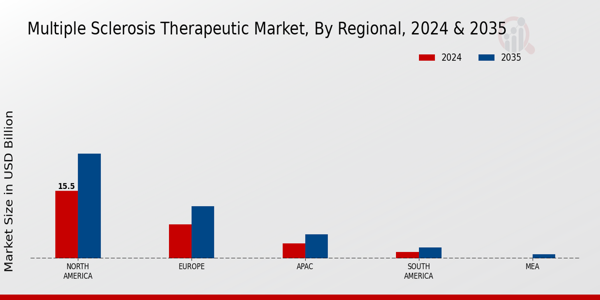Rising Prevalence of Multiple Sclerosis
The increasing prevalence of Multiple Sclerosis (MS) is a pivotal driver for the Multiple Sclerosis Therapeutic Market. Recent estimates suggest that approximately 2.3 million individuals are affected by MS worldwide, with a notable rise in cases reported annually. This surge in prevalence necessitates the development and availability of effective therapeutic options, thereby propelling market growth. As the understanding of MS evolves, the demand for innovative treatments that address the diverse needs of patients becomes paramount. The Multiple Sclerosis Therapeutic Market is thus positioned to expand significantly, driven by the urgent need for therapies that can manage symptoms and improve the quality of life for those affected. Furthermore, the increasing awareness and diagnosis of MS contribute to the growing patient population, further stimulating market dynamics.
Advancements in Research and Development
Ongoing advancements in research and development (R&D) are crucial for the evolution of the Multiple Sclerosis Therapeutic Market. The scientific community is actively exploring novel therapeutic approaches, including monoclonal antibodies and small molecules, which have shown promise in clinical trials. For instance, recent breakthroughs in understanding the immunological mechanisms underlying MS have led to the identification of new therapeutic targets. This innovation is expected to enhance treatment efficacy and safety profiles, thereby attracting investment and interest from pharmaceutical companies. The Multiple Sclerosis Therapeutic Market is likely to benefit from these advancements, as new therapies enter the market and existing treatments are optimized. The continuous influx of research funding and collaboration between academia and industry further underscores the potential for transformative therapies that could redefine MS management.
Growing Awareness and Education Initiatives
The increasing awareness and education initiatives surrounding Multiple Sclerosis are instrumental in shaping the Multiple Sclerosis Therapeutic Market. Campaigns aimed at educating both healthcare professionals and the public about MS symptoms, treatment options, and the importance of early diagnosis are gaining momentum. This heightened awareness is likely to lead to earlier detection and treatment of MS, which can significantly improve patient outcomes. Furthermore, as patients become more informed about their condition, they may actively seek out available therapies, thereby driving demand within the Multiple Sclerosis Therapeutic Market. Organizations dedicated to MS advocacy are playing a vital role in these initiatives, fostering a community that supports research and access to innovative treatments. The ripple effect of these educational efforts is expected to enhance the overall landscape of MS management.
Regulatory Support for Innovative Therapies
Regulatory support for innovative therapies is emerging as a key driver in the Multiple Sclerosis Therapeutic Market. Regulatory agencies are increasingly recognizing the need for expedited approval processes for novel treatments that demonstrate significant therapeutic benefits. This trend is particularly relevant for therapies that address unmet medical needs in MS, as they can potentially transform patient care. The introduction of programs aimed at facilitating faster access to promising therapies is likely to encourage pharmaceutical companies to invest in MS research and development. As a result, the Multiple Sclerosis Therapeutic Market may witness a surge in the availability of new treatment options, enhancing competition and ultimately benefiting patients. The collaborative efforts between regulatory bodies and industry stakeholders are expected to foster an environment conducive to innovation, thereby shaping the future of MS therapeutics.
Increased Investment in Healthcare Infrastructure
The growing investment in healthcare infrastructure is a significant driver for the Multiple Sclerosis Therapeutic Market. Governments and private entities are increasingly allocating resources to enhance healthcare systems, which includes improving access to MS treatments. This investment is particularly evident in regions where healthcare disparities exist, as efforts are made to ensure that patients receive timely and effective care. Enhanced healthcare infrastructure facilitates better diagnosis, treatment, and management of MS, thereby fostering a more favorable environment for the Multiple Sclerosis Therapeutic Market. Additionally, the establishment of specialized MS clinics and treatment centers is likely to improve patient outcomes and adherence to therapy, further driving market growth. As healthcare systems evolve, the demand for comprehensive MS care is expected to rise, creating opportunities for therapeutic advancements.


















Leave a Comment